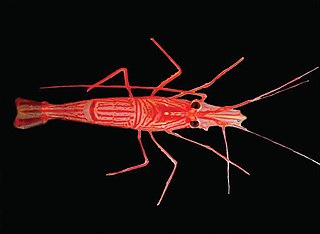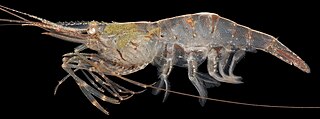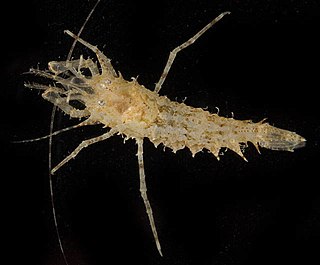
The Caridea, commonly known as caridean shrimp or true shrimp, are an infraorder of shrimp within the order Decapoda. This infraorder contains all species of true shrimp. They are found widely around the world in both fresh and salt water. Many other animals with similar names – such as the mud shrimp of Axiidea and the boxer shrimp of Stenopodidea – are not true shrimp, but many have evolved features similar to true shrimp.

Hippolytidae is a family of cleaner shrimp, also known as broken-back shrimp or anemone shrimp. The term "broken-back shrimp" also applies to the genus Hippolyte in particular and "cleaner shrimp" is sometimes applied exclusively to Lysmata amboinensis.

Lysmata debelius is a species of cleaner shrimp indigenous to the Indo-Pacific. It is popular in the aquarium trade, where it is known as the fire shrimp, blood shrimp or scarlet cleaner shrimp.

Psalidopus is a genus of shrimp placed in its own family, Psalidopodidae, and superfamily, Psalidopodoidea. It comprises three species, one in the western Atlantic Ocean, and two in the Indo-Pacific.
Cryptogemma cornea is a species of sea snail, a marine gastropod mollusk in the family Turridae, the turrids.
Abyssotrophon crystallinus is a species of sea snail, a marine gastropod mollusk in the family Muricidae, the murex snails or rock snails.

Lysmata is a genus of shrimp in the infraorder Caridea, the caridean shrimp. The genus belongs to the family Lysmatidae. Lysmata are popular ornamental shrimp in the marine aquarium trade for their bright color patterns, interesting behaviors, and ability to control certain aquarium pests such as sea anemones of the genus Aiptasia. They are known to command high prices on the pet market.

Alope is a genus of shrimp in the family Hippolytidae, comprising two species:
Birulia kishinouyei is a shrimp species in the genus Birulia. Its specific epithet is a tribute to the Japanese fisheries biologist Kamakichi Kishinouye.

A shrimp is a crustacean with an elongated body and a primarily swimming mode of locomotion – typically belonging to the Caridea or Dendrobranchiata of the decapod order, although some crustaceans outside of this order are also referred to as "shrimp".

Prawn is a common name for small aquatic crustaceans with an exoskeleton and ten legs, some of which are edible.
Copulabyssia similaris is a species of small sea snail, a marine gastropod mollusk in the family Pseudococculinidae, the false limpets.

Lucensosergia lucens is a species of shrimp popularly known as the sakura shrimp or sakura ebi. The translucent pink shrimp derives its name from sakura, the Japanese word for the cherry blossom. The species grows to about 4–5 cm and lives primarily in Suruga Bay in Shizuoka Prefecture, Japan, where it is caught to be eaten. It is also caught in Taiwan.

Lysmata boggessi is a species of saltwater shrimp first classified as Lysmata wurdemanni. It is found in shallow waters of the Atlantic Ocean, and can be distinguished by its coloration pattern.

Lysmata ankeri is a species of saltwater shrimp first classified as Lysmata wurdemanni. It is found in shallow waters of the Atlantic Ocean, and can be distinguished by its coloration pattern.

Thoridae, also known as broken-back shrimp or anemone shrimp, is a family of cleaner shrimp.
Parhippolyte is a genus of cave dwelling decapod crustaceans, known as cave shrimps from the family Barbouriidae The type species Parhippolyte uveae was described in 1900 by the English carcinologist Lancelot Alexander Borradaile from specimens collected in the south western Pacific by Arthur Willey. As their vernacular name of cave shrimp suggests these species are generally found in marine caves as well as anchialine ponds and lagoons.

Saron marmoratus, the marbled shrimp, is a species of "cleaner shrimp" from the family Thoridae, although its taxonomic position is subject to some controversy as many authorities have considered it to be a member of the family Hippolytidae sensu lato. It's normally found in the Indo-Pacific region but in 2013 it was found off the coast of Lebanon, probably having reached the Mediterranean by Lessepsian migration through the Suez Canal from the Red Sea. It is a popular species in aquaria due to its easy care.

Palaemon macrodactylus is a species of shrimp of the family Palaemonidae.

Paracrangon is a genus of deep-sea shrimp in the family Crangonidae, found on the Pacific coasts of North America, Asia, and Australia. Morphologically, they are notable for several autapomorphies, most significantly their unique lack of second pereopods, but also for their partially flexible abdomen, which allows them to assume their defensive cataleptic posture. Species also have long spines covering their carapace. They are distinctive among the Crangonid shrimp, and are almost certainly monophyletic. All species except Paracrangon echinata, the type species, are quite rare.













